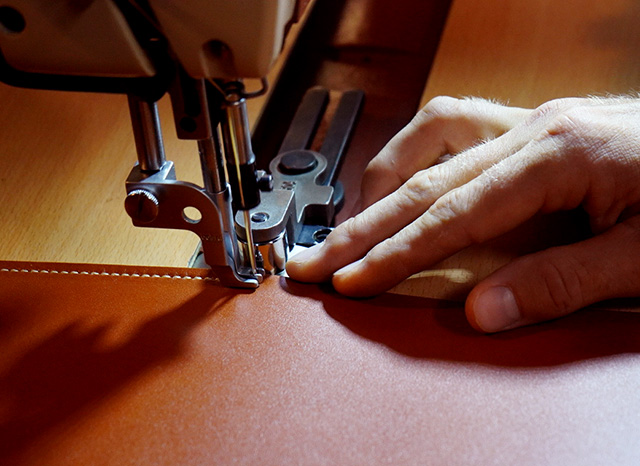- Home
- TCO Leather Goods
- Leather Basics
What is leather?
Leather is a versatile natural material that comes from animal skin and processed by a tanner. The corium, the most important part of the skin and sits right below the hair roots, is composed of collagen fibers that are woven together to provide that special structure and characteristics leather is known for — strength, elasticity, and breathability.
Imagine turning a tough animal hide into that beautiful leather backpack you love! Tanning is the process of chemically and biologically stabilizing the animal skin to transform it into leather. But first, the hair and epidermis layer on top have to be removed (liming), as well as the layer of flesh from underneath (fleshing), before tanning can begin.

Two popular tanning methods:
Vegetable tanning
Vegetable tanning is a natural tanning method which involves immersing the skin in a tannin solution made from tree bark, twigs, leaves, and water. The choice of tanning material and chemical composition of the solution determine the quality, characteristics, and color of the leather.
The tannins slowly soak in and bind with the proteins in the hide, making it super strong and preventing it from rotting. This part can take weeks, and sometimes even months because good things take time!
We love working with vegetable-tanned leather because of the distinct appeal, including its smell, texture, flexibility, and how it changes over time and use.
Chrome tanning
Instead of a long soak in a natural tub, chrome tanning uses a special kind of salt with chromium in it. This chromium acts like tiny anchors, grabbing onto the hide's proteins and holding them together. This makes the leather really strong and keeps it from spoiling. The cool thing is, this chrome tan only takes about a day, much faster than the vegetable tanning tea bath.
Once the tanning is complete, the leather gets some finishing touches. It might be treated with natural oils or wax to make it soft and supple, and maybe even dyed a cool color. Finally, it gets dried out slowly to achieve the perfect texture.
What are full grain and top grain leather?

Leather comes in different grades that provide the specific characteristics and feel of the leather. We work with two top premium leather grades available — full grain and top grain leather. They are cream-of-the-crop and we'll explain the differences here.
Full grain leather
Full grain leather is like the superhero of leathers. It's the toughest, most natural kind you can find. Here's why it's so special:
- Super strong: Full grain leather is the top layer of the animal's hide, with all the natural strength and thickness. It's built to last a lifetime!
- Breathes easy: Unlike some other leathers, full grain has all its pores intact. This means it lets your skin breathe, which is great for things like jackets and shoes.
- Develops character: Full grain leather keeps the natural markings and wrinkles of the hide. These imperfections are like a birthmark, making every piece unique and full of character. The leather will also age beautifully, developing a rich patina over time.
- Needs some TLC: Because it's so natural, it might be more susceptible to stains than other leathers. But with a little care and conditioner, it'll stay gorgeous for years.
Think of it like your favorite well-worn jeans — they might have some wrinkles and fades, but that's what makes them comfy and tells their story. Full grain leather is like that, but even stronger and more luxurious.
Top grain leather
Top grain leather is like the second-best cut of steak for leather. It's really good, but not quite the absolute top. Here's what makes it great:
- Durable: Top grain leather is tough and can last for years, making it a good choice for furniture, wallets, and bags that you use a lot.
- Looks nice: It has a smooth surface that can look really nice, and it often comes in a variety of colors.
- More affordable: Top grain leather is usually cheaper than the absolute top grade, full grain leather.
Top grain leather sometimes has a protective coating that can make it a little less breathable and prevent it from developing a natural patina over time, which is when leather gets a beautiful aged look. But that coating also helps make it more stain resistant.
Where we source our leather
We source our leather from the top reputable tanneries around the country.
Hermann Oak Leather
Hermann Oak is a family-run business that started in 1881 and is one of the oldest tanneries in the country. They produce the highest grade vegetable tanned leather using the traditional tanning process that's been passed down for generations. The natural process of soaking leather in tree barks takes time but the end result is the finest leather we can get our hands on.
Wickett & Craig Leather
Wickett & Craig was founded in 1886 and is one of the only specialty vegetable tanneries in the United States. They're known for their dedication to traditional methods and the exceptional quality of their leather, prized by artisans and crafters around the world. Throughout the years, Wickett & Craig has adapted to changing markets. While equestrian products were once a big focus, the rise of luxury goods has seen them cater to a wider range of uses for their leather.
